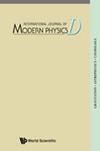General formulae for the periapsis shift of a quasi-circular orbit in static spherically symmetric spacetimes and the active gravitational mass density
IF 2.1
4区 物理与天体物理
Q3 ASTRONOMY & ASTROPHYSICS
引用次数: 0
Abstract
We study the periapsis shift of a quasi-circular orbit in general static spherically symmetric spacetimes. We derive two formulae in full order with respect to the gravitational field, one in terms of the gravitational mass $m$ and the Einstein tensor and the other in terms of the orbital angular velocity and the Einstein tensor. These formulae reproduce the well-known ones for the forward shift in the Schwarzschild spacetime. In a general case, the shift deviates from that in the vacuum spacetime due to a particular combination of the components of the Einstein tensor at the radius $r$ of the orbit. The formulae give a backward shift due to the extended-mass effect in Newtonian gravity. In general relativity, in the weak-field and diffuse regime, the active gravitational mass density, $\rho_{A}=(\epsilon+p_{r}+2p_{t})/c^{2}$, plays an important role, where $\epsilon$, $p_{r}$, and $p_{t}$ are the energy density, the radial stress, and the tangential stress of the matter field, respectively. We show that the shift is backward if $\rho_{A}$ is beyond a critical value $\rho_{c}\simeq 2.8\times 10^{-15} \mbox{g}/\mbox{cm}^{3} (m/M_{\odot})^{2}(r/\mbox{au})^{-4}$, while a forward shift greater than that in the vacuum spacetime instead implies $\rho_{A}<0$, i.e., the violation of the strong energy condition, and thereby provides evidence for dark energy. We obtain new observational constraints on $\rho_{A}$ in the Solar System and the Galactic Centre.静态球对称时空中准圆轨道近点位移和活动重力质量密度的一般公式
本文章由计算机程序翻译,如有差异,请以英文原文为准。
求助全文
约1分钟内获得全文
求助全文
来源期刊

International Journal of Modern Physics D
地学天文-天文与天体物理
CiteScore
3.80
自引率
9.10%
发文量
181
审稿时长
4-8 weeks
期刊介绍:
Gravitation, astrophysics and cosmology are exciting and rapidly advancing fields of research. This journal aims to accommodate and promote this expansion of information and ideas and it features research papers and reviews on theoretical, observational and experimental findings in these fields. Among the topics covered are general relativity, quantum gravity, gravitational experiments, quantum cosmology, observational cosmology, particle cosmology, large scale structure, high energy astrophysics, compact objects, cosmic particles and radiation.
 求助内容:
求助内容: 应助结果提醒方式:
应助结果提醒方式:


